The Australian Outback, with its vast reddish plains, sparse woodlands, and striking landscapes, is home to some of the world’s most extraordinary birdlife. Far from being a barren wasteland, this seemingly inhospitable environment hosts a remarkable diversity of avian species that have adapted ingeniously to thrive in challenging conditions. From flamboyantly colored parrots to majestic birds of prey, the feathered inhabitants of the Outback showcase nature’s ability to evolve remarkable solutions for survival. These birds not only add vibrant splashes of color to the ochre landscape but also play vital ecological roles in Australia’s delicate desert ecosystems. Let’s explore some of the most spectacular birds that call the Australian Outback home, uncovering their unique adaptations, behaviors, and cultural significance.
The Emblematic Emu: Australia’s Iconic Flightless Giant
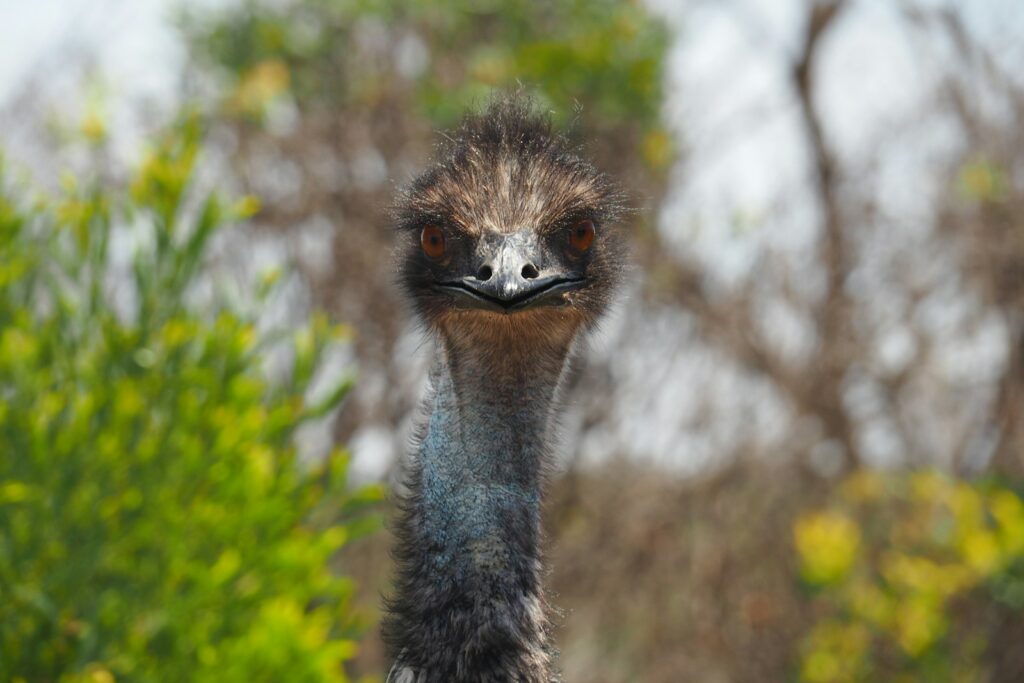
Standing as tall as 1.9 meters, the emu (Dromaius novaehollandiae) is the second-largest bird in the world by height and a quintessential symbol of the Australian Outback. These imposing flightless birds have adapted perfectly to the harsh conditions with their remarkable ability to go for weeks without drinking water when necessary. Emus possess powerful legs that enable them to sprint at speeds reaching 50 kilometers per hour, making them exceptionally effective at traversing vast Outback distances. Their feathers, which appear shaggy and hair-like, provide excellent insulation against both the scorching daytime heat and surprisingly cold desert nights. Culturally significant to Indigenous Australians for thousands of years, emus feature prominently in Dreamtime stories and were traditionally valued for their meat, oil, and feathers.
Wedge-tailed Eagle: The Outback’s Aerial Predator
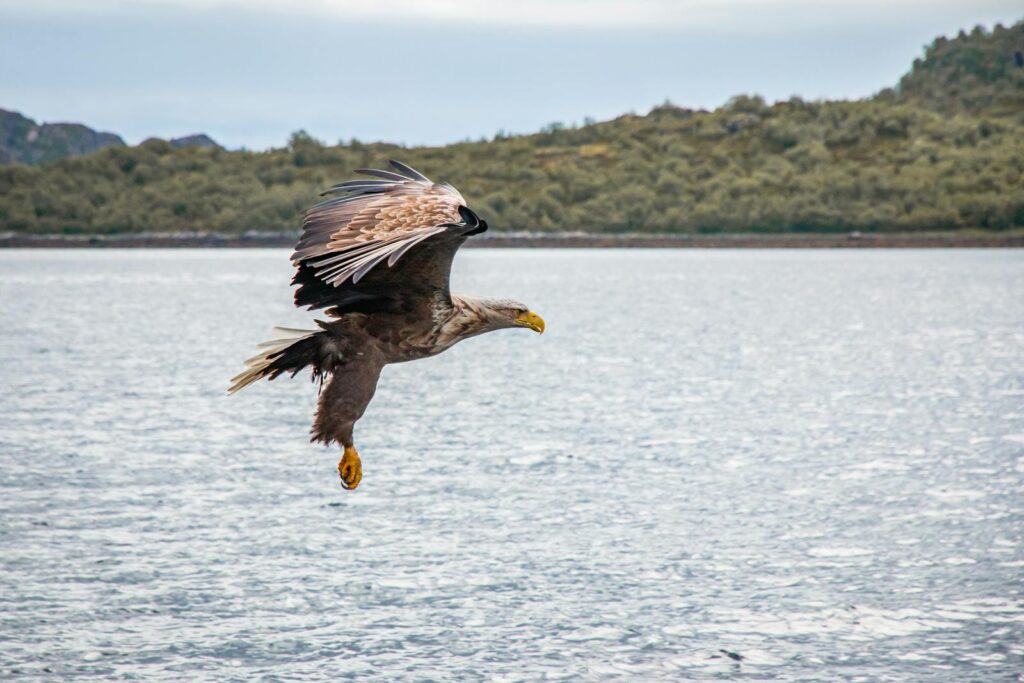
The wedge-tailed eagle (Aquila audax) reigns supreme as Australia’s largest bird of prey, with an awe-inspiring wingspan that can exceed 2.3 meters. These majestic raptors can be spotted soaring effortlessly on thermal currents high above the Outback, their distinctive wedge-shaped tail visible even from great distances. Primarily feeding on kangaroos, rabbits, and other medium-sized mammals, these powerful predators have even been observed hunting in pairs to take down larger prey such as young kangaroos. Wedge-tailed eagles construct massive nests, some measuring up to 2 meters across and weighing over 400 kilograms, which they may reuse and expand for decades. Their exceptional eyesight allows them to spot prey from kilometers away, making them perfectly adapted to the expansive, open landscapes of the Outback.
Galah: The Pink and Gray Entertainer

With their distinctive rose-pink and gray plumage, galahs (Eolophus roseicapilla) bring a spectacular splash of color to the Outback’s muted palette. These medium-sized cockatoos, also known as the rose-breasted cockatoo, travel in large, noisy flocks that can number in the thousands during non-breeding seasons. Highly social and intelligent, galahs are known for their playful antics, often seen hanging upside down from branches or performing aerial acrobatics that seem purely for enjoyment. Their remarkable adaptability has allowed them to thrive despite human landscape modifications, and they’ve even expanded their range as agriculture has spread across Australia. In Australian slang, calling someone a “galah” refers to a fool or silly person, inspired by these birds’ seemingly clownish behavior – though this characterization hardly does justice to their considerable intelligence and complex social structures.
Major Mitchell’s Cockatoo: The Desert’s Pink Princess
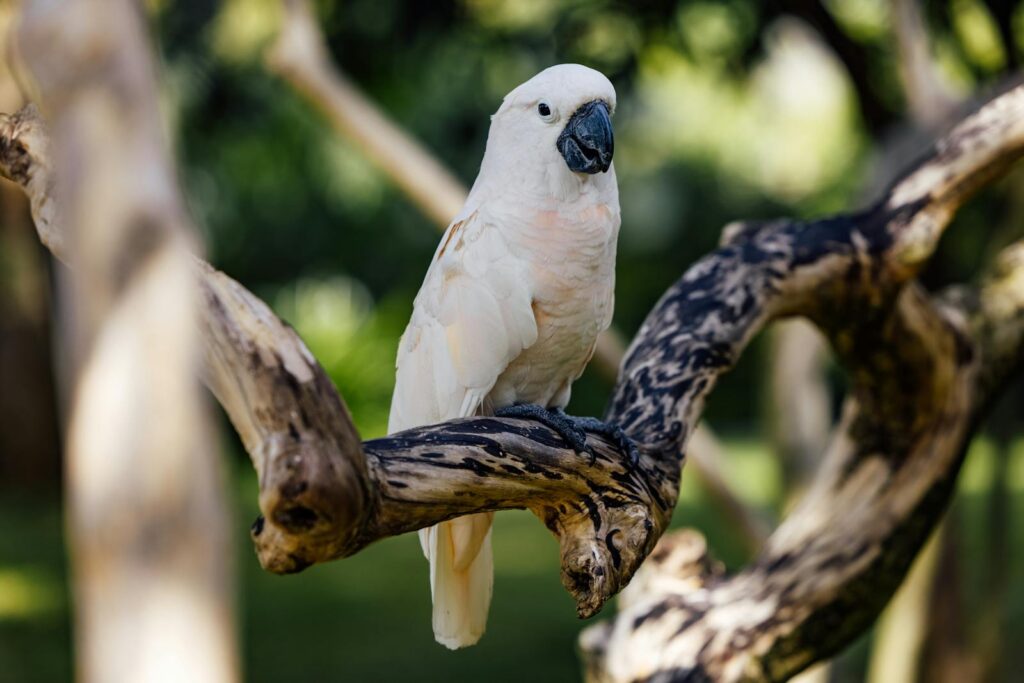
Perhaps the most visually striking of all Outback birds, Major Mitchell’s cockatoo (Lophochroa leadbeateri) sports a spectacular salmon-pink plumage and an elaborate red and yellow striped crest that unfurls like a fan when the bird is excited or alarmed. Named after explorer and surveyor Major Sir Thomas Mitchell, these medium-sized cockatoos are less common than many other parrot species, preferring the arid and semi-arid regions of inland Australia. Unlike their more adaptable cockatoo relatives, Major Mitchell’s have not adjusted well to human landscape modifications, maintaining a strong preference for undisturbed mallee woodlands and native pine stands. Their striking appearance is complemented by their intelligence and complex vocalizations, which include a wide repertoire of calls ranging from harsh screeches to melodious whistles. Despite their beauty, these birds face mounting conservation challenges due to habitat loss and illegal trapping for the pet trade.
Australian Bustard: The Stately Desert Wanderer

The Australian bustard (Ardeotis australis), known to Indigenous Australians as the bush turkey, is one of the country’s largest land birds, with males standing up to one meter tall. These stately birds possess a distinctive upright posture, long legs, and a slow, deliberate walking gait that gives them an almost regal bearing as they stalk through the grasslands and open woodlands of the Outback. During breeding season, male bustards perform elaborate courtship displays, inflating a large throat sac and strutting with their tails cocked upward to impress potential mates. Historically, an important food source for Indigenous peoples, bustard populations declined significantly following European settlement due to hunting and habitat modification. Though still widespread across northern Australia, these magnificent birds are increasingly rare in southern regions, where they were once abundant across the inland plains.
Budgerigar: The Desert’s Living Rainbow
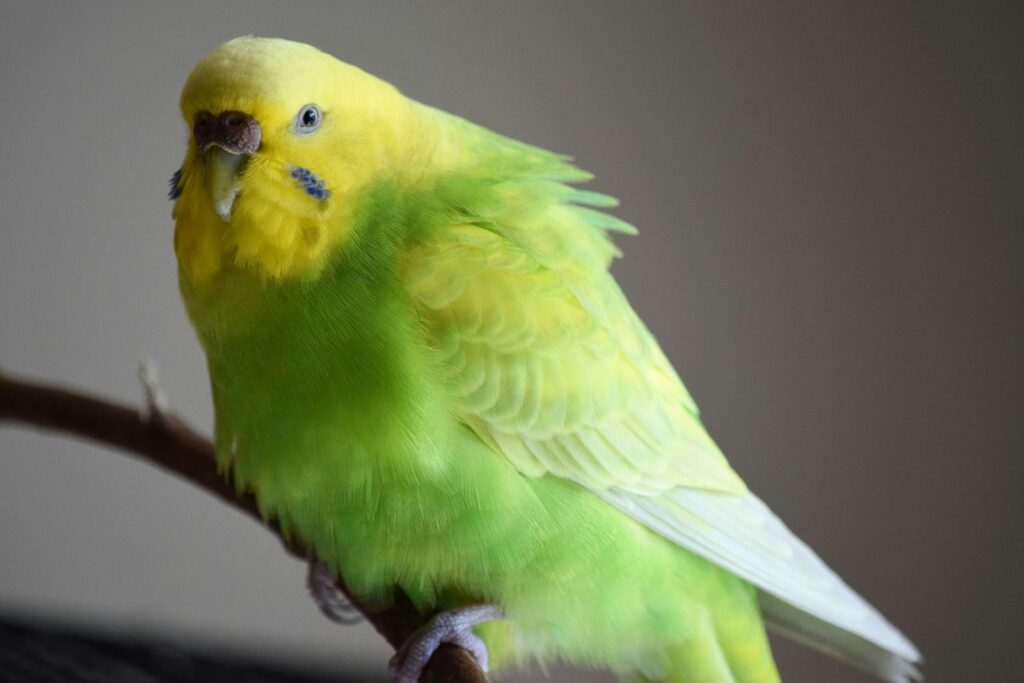
While many people know budgerigars (Melopsittacus undulatus) only as caged pets, these small parrots are naturally occurring Outback specialists that travel in enormous, undulating flocks that can number in the tens of thousands. In their native habitat, these birds display a primarily green plumage with black barring on their wings and back – quite different from the blue, yellow, and white variations developed through selective breeding for the pet trade. When rainfall transforms the desert, budgerigars respond with explosive breeding events, with pairs producing multiple clutches in rapid succession to take advantage of temporary abundance. Their ability to detect distant rainfall and travel hundreds of kilometers to reach newly watered areas makes them true nomads of the Outback. Perhaps most remarkably, these small birds can survive without drinking water for extended periods, obtaining moisture from seeds and occasionally morning dew.
Spinifex Pigeon: Master of Desert Camouflage
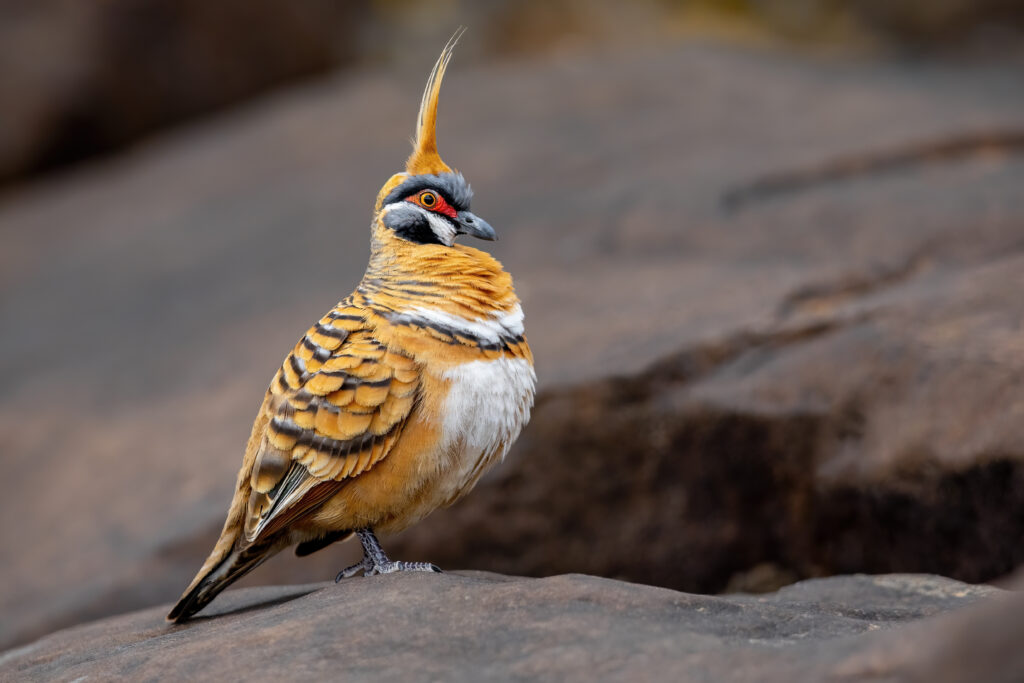
The spinifex pigeon (Geophaps plumifera) represents one of the most remarkable examples of evolutionary adaptation to the harsh Outback environment among Australian birds. Their rusty-brown coloration perfectly matches the red soils and spinifex grass clumps of their arid habitat, providing exceptional camouflage against predators. Unlike most pigeons, these ground-dwelling birds rarely drink water, having evolved to extract sufficient moisture from their seed diet and to conserve water through physiological adaptations. Their most distinctive feature is the dramatic crest adorning their head, which stands erect like a spiky crown, adding to their unique appearance. When threatened, spinifex pigeons will often freeze in place rather than flying, relying on their camouflage for protection – and when they do take flight, they typically fly only a short distance before landing and resuming their motionless stance.
Crimson Chat: Vibrant Jewel of the Desert
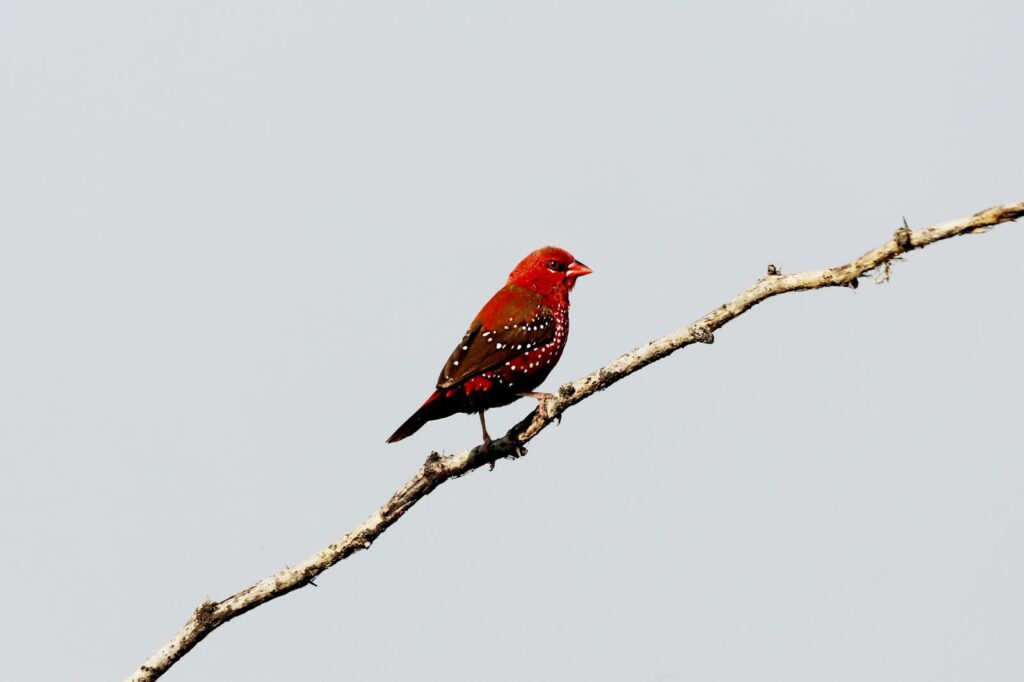
The crimson chat (Epthianura tricolor) brings an unexpected burst of vivid color to the otherwise subdued palette of the Outback landscape. Males of this small songbird species sport a brilliant scarlet crown, breast, and upper belly that create a striking contrast against their white throat and gray-brown wings. These nomadic birds follow a boom-and-bust lifestyle perfectly adapted to the unpredictable nature of Australia’s arid interior, appearing suddenly in areas that have received recent rainfall. Their breeding cycle is remarkably opportunistic, with pairs capable of nesting multiple times in quick succession when conditions are favorable, only to disappear entirely from the region when drought returns. Crimson chats feed primarily on insects gleaned from low desert vegetation, and they’ve developed the ability to survive with minimal free water, obtaining most of their moisture from their prey.
Australian Ringneck: The Color-Changing Parrot
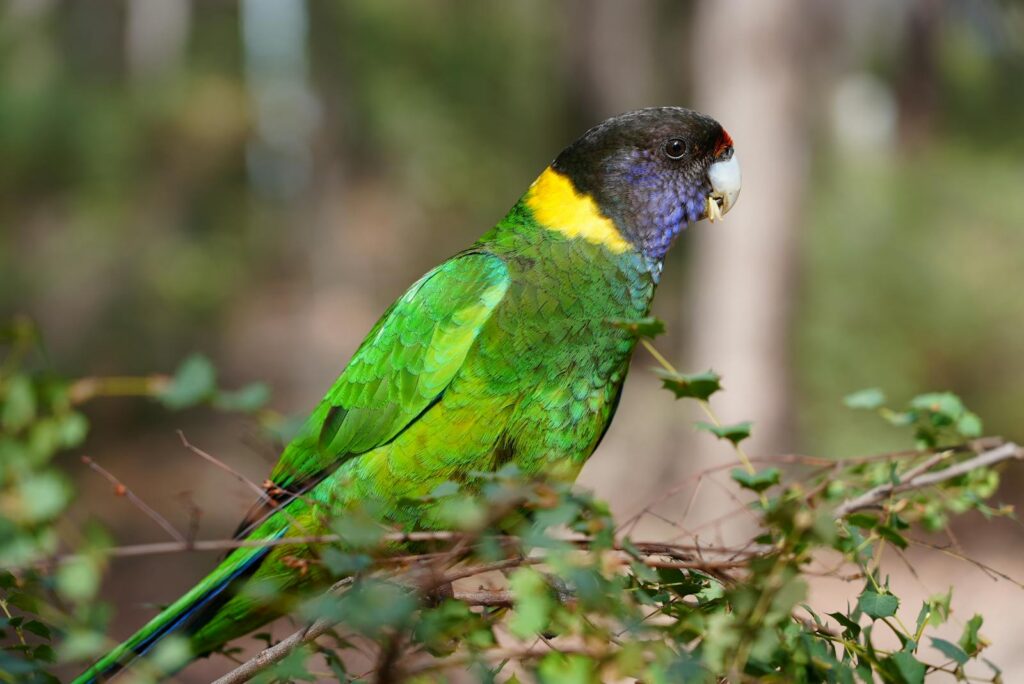
The Australian ringneck (Barnardius zonarius) exists in several distinct forms across different regions of the Outback, with variations in plumage so significant that they were once considered separate species. In the western parts of their range, these medium-sized parrots display predominantly green plumage with a black head and yellow neck ring, while eastern populations feature more extensive yellow coloration, creating an intriguing geographic gradient across the continent. All varieties share a swift, direct flight pattern and loud, clear calls that carry impressively far across open Outback landscapes. Despite their often harsh environment, ringnecks have adapted to use a wide variety of food sources, from native seeds and fruits to nectar, blossoms, and insects, contributing to their success across diverse habitats. Their remarkable intelligence and resilience have allowed them to persist and even thrive in areas where many other species have declined due to human impacts.
Letter-winged Kite: Nocturnal Hunter of the Inland
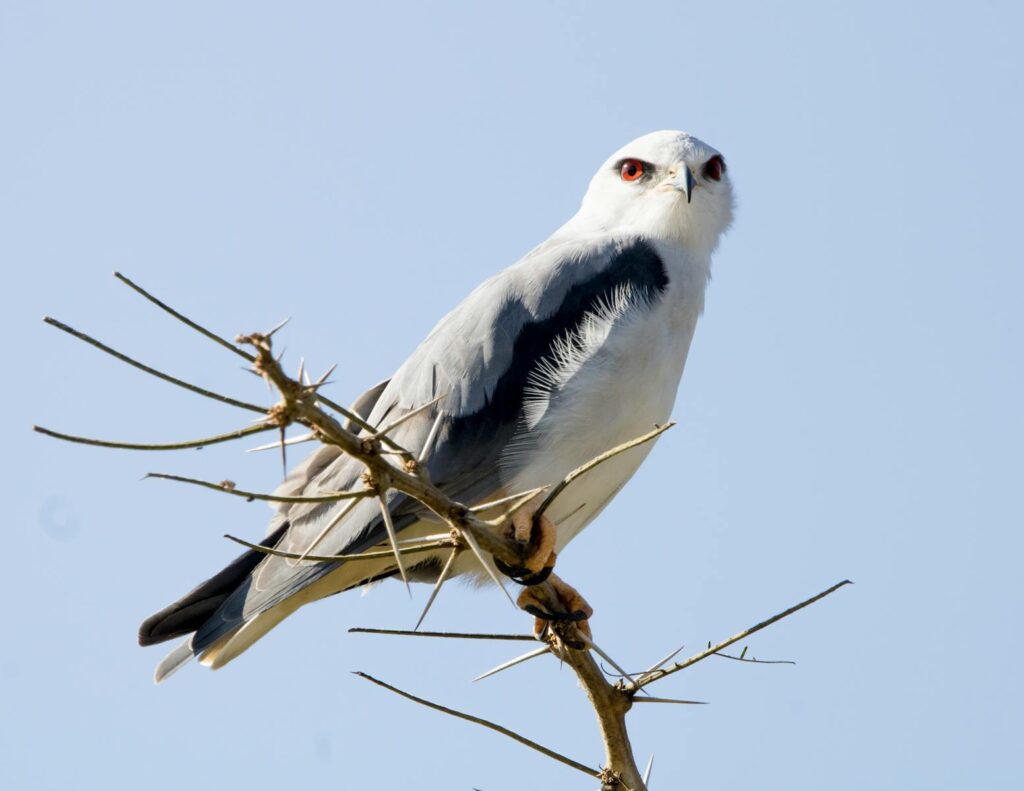
Unlike most raptors, the letter-winged kite (Elanus scriptus) hunts primarily at night, making it one of the few nocturnal birds of prey in Australia. This specialized hunting strategy allows them to target the desert’s abundant rodent populations when they’re most active, particularly the long-haired rat that experiences population explosions after good rains. Their name derives from the distinctive black ‘M’ or ‘W’ pattern visible on the underwing, which resembles a letter when the bird is in flight. With their pale gray and white plumage, striking black shoulder patches, and piercing red eyes, letter-winged kites present a ghostly appearance as they hover over the moonlit Outback searching for prey. These medium-sized raptors are true Outback specialists, rarely found outside the arid interior of the continent, and they often nest communally in isolated stands of trees near ephemeral wetlands or watercourses.
Zebra Finch: Soundtrack of the Desert
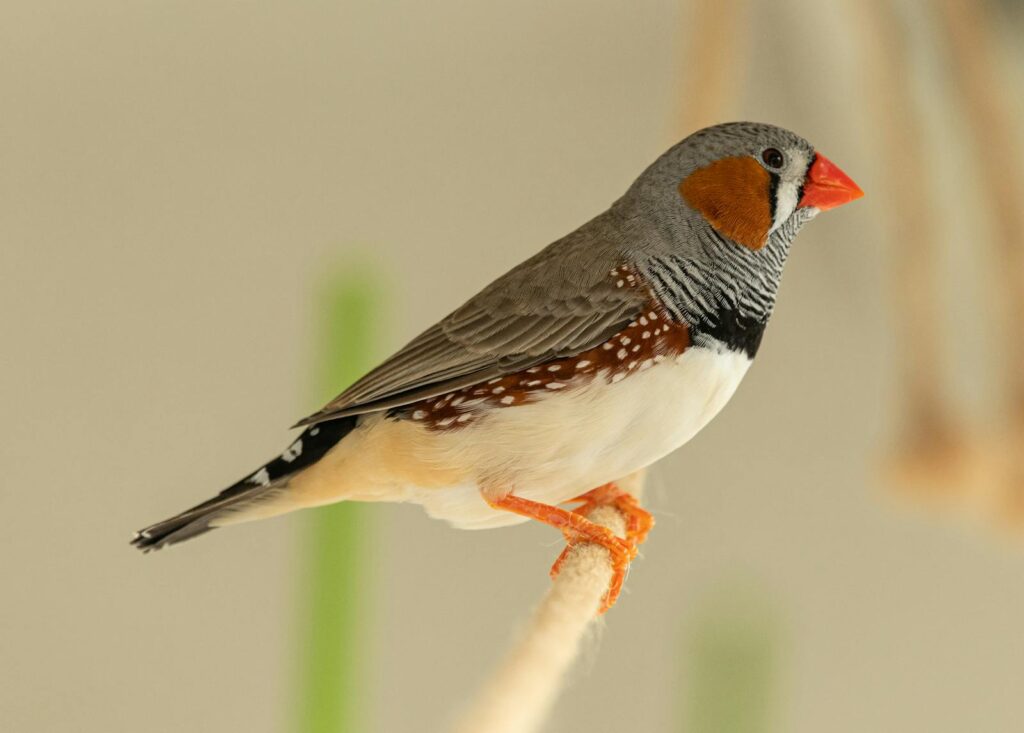
The zebra finch (Taeniopygia guttata) may be small in size, but it makes an outsized contribution to the Outback’s soundscape with its constant, cheerful chattering calls. These tiny, sociable birds are perfectly adapted to arid conditions, capable of breeding after even minimal rainfall and surviving extended drought periods by concentrating their urine to conserve water. Male zebra finches are instantly recognizable by their striking black and white barring, chestnut-colored ear patches, and bright orange beaks, while females display more subdued coloration. Their remarkable ability to breed opportunistically has made them one of the most successful and abundant bird species in the Outback, sometimes gathering in flocks numbering in the thousands around water sources. Scientific research has revealed that zebra finches can travel more than 40 kilometers daily between nesting sites and water sources, an impressive feat for a bird weighing less than 12 grams.
Inland Dotterel: Master of Desert Disappearance
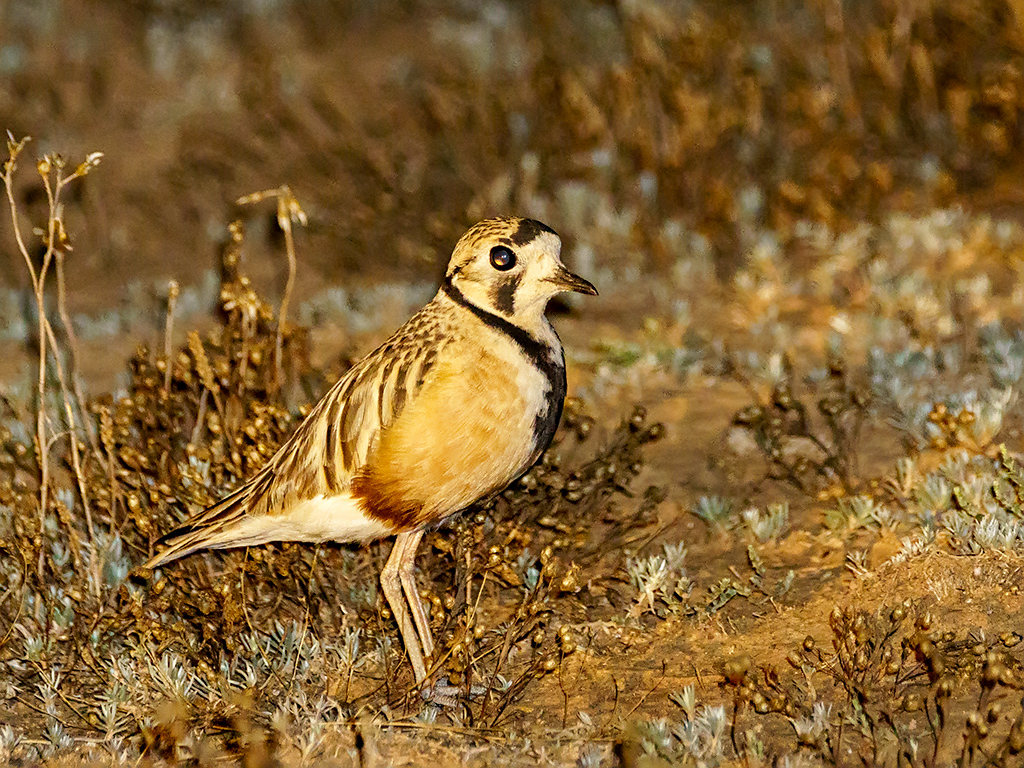
The inland dotterel (Peltohyas australis) exemplifies cryptic camouflage, with plumage that so perfectly matches the stony desert plains that the bird seems to vanish before one’s eyes when it stands still. These medium-sized waders have abandoned the typical shorebird lifestyle of their relatives, adapting instead to the arid interior where they sprint across open gibber plains and clay pans using their long legs. Unlike most birds, inland dotterels are primarily nocturnal, becoming more active during evening and night hours when the desert heat subsides. Their most unusual characteristic is their breeding behavior – males, rather than females, take responsibility for incubating the eggs and caring for the young, a role reversal rare among birds. When threatened, inland dotterels employ a distinctive defense strategy of crouching low against the ground and extending their neck horizontally, rendering them nearly invisible against the desert floor.
Brolga: The Elegant Desert Dancer
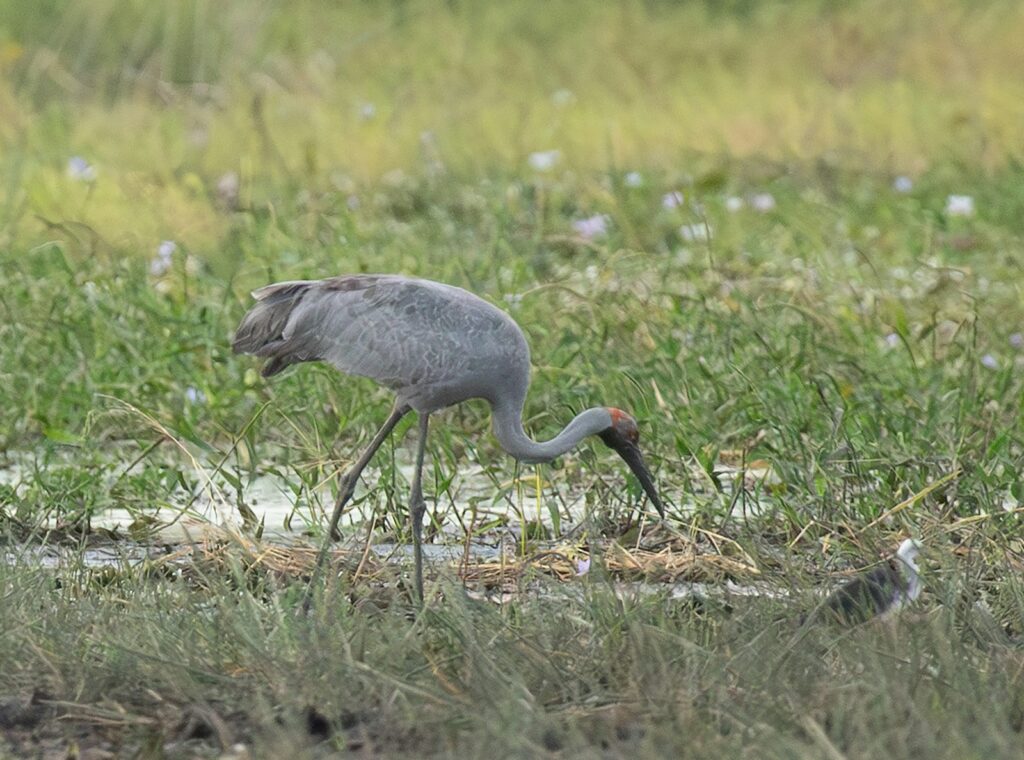
Standing over 1.3 meters tall, the stately brolga (Antigone rubicunda) brings elegance and grace to the Outback wetlands and plains. These magnificent gray cranes are renowned for their elaborate courtship dances, which involve a complex series of bowing, jumping, wing-spreading, and trumpeting calls that pairs perform in perfect coordination. Indigenous Australians have long revered the brolga, incorporating its distinctive movements into ceremonial dances that have been performed for thousands of years. During dry seasons, these adaptable birds will travel considerable distances to find suitable wetlands, sometimes forming flocks numbering in the hundreds at permanent water sources. Brolgas maintain strong pair bonds that often last for many years, with couples defending territories where they build their large platform nests among reeds or on small islands in shallow waters.
Conservation Challenges for Outback Birds
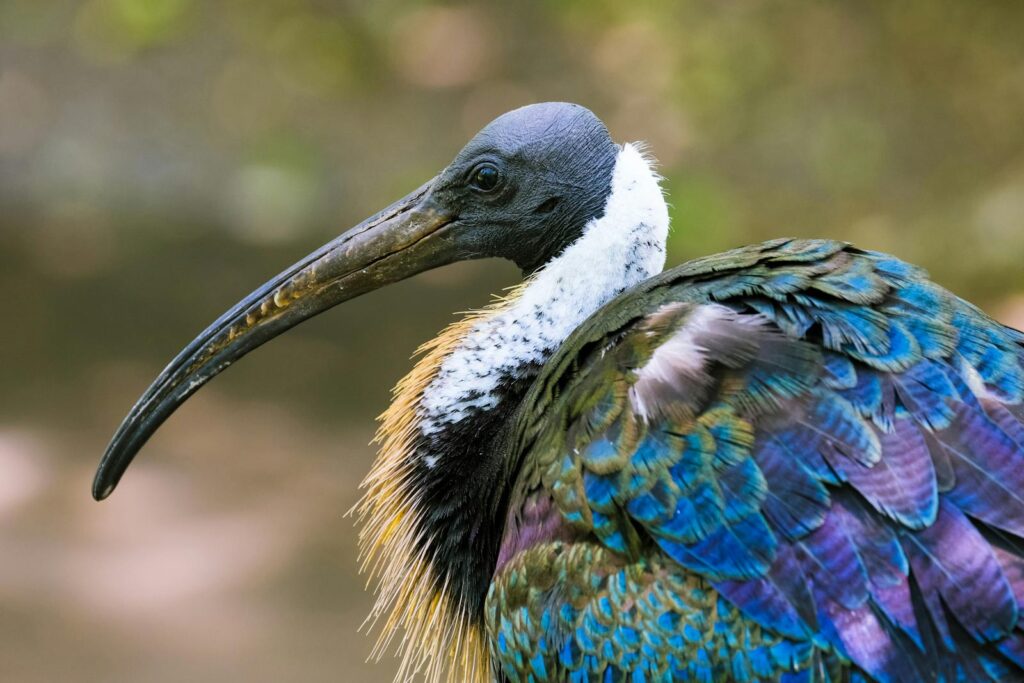
Despite their remarkable adaptations, many bird species of the Australian Outback face significant and growing threats to their survival. Habitat modification through land clearing, overgrazing, and altered fire regimes has disrupted the delicate ecosystems these species depend upon. Introduced predators like cats and foxes take a devastating toll on ground-nesting species such as the inland dotterel and bustard, whose evolutionary history left them unprepared for these efficient hunters. Climate change presents perhaps the most profound long-term threat, with predictions of more frequent and severe droughts potentially exceeding even the remarkable adaptive capabilities of Outback specialists. Conservation efforts are increasingly focused on establishing large protected areas that maintain intact habitat networks, implementing targeted predator control programs, and developing water management strategies that consider the needs of native wildlife. The future of these spectacular birds depends largely on humans’ willingness to adapt our own behaviors to ensure their continued existence.
Conclusion
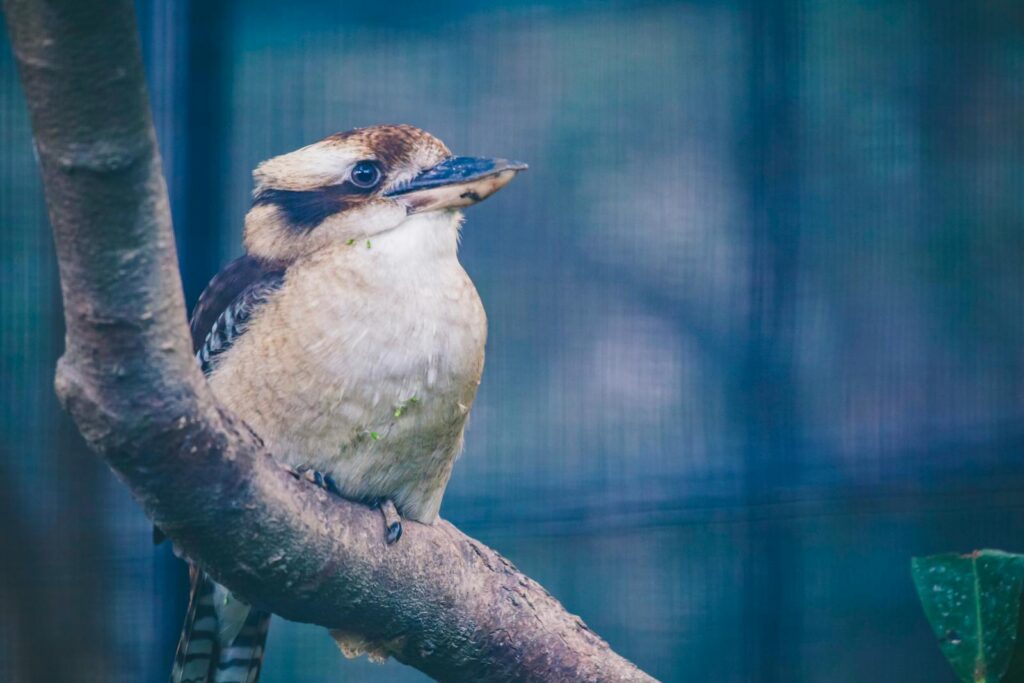
The birds of the Australian Outback represent nature’s ingenuity at its finest – a collection of species that have evolved extraordinary adaptations to not merely survive but thrive in one of Earth’s most challenging environments. From the mighty emu to the diminutive zebra finch, each species contributes to the ecological tapestry of the Outback and holds practical and spiritual significance for Australia’s people. As we face an era of unprecedented environmental change, these remarkable birds serve as both indicators of ecosystem health and ambassadors for conservation. Their continued presence across the vast interior landscapes of Australia would signify success in preserving not just individual species, but entire functioning ecosystems. The spectacular birds of the Outback remind us that even in seemingly harsh and unforgiving places, life finds remarkable ways to express itself with beauty, resilience, and endless creativity.
